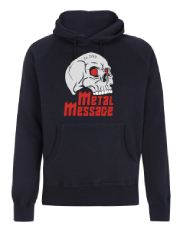

| Interview: | KORPIKLAANI |
| Title: | With immense effort |
With their previous 2011 longplayer „Ukon Wacka“ the playful Folk Metal protagonists of Korpiklaani could clearing well on a broad front once more.
And already eagerly awaited by the fans, the exceptionally diligent Finns created already a new album: „Manala“. And for their eighth collection of songs the successful six-strong horde, according the album title, brings music about the mysterious underworld „Manala“, that describes in Finnish mythology the gloomy realm of the dead.
Various Metal and Folk bands from the home country of our heroes around frontman Jonne Järvelä handled on lyrical level also already with the three cognate terms Tuonela, Tuoni und Mana. Insiders know the editorial context from the famous Finnish national epic, the Kalevala.
Korpiklaani developed for its new publication an exciting and entertaining lyrical concept, which includes, true to the image of the band, again all sorts of shamanic interests.
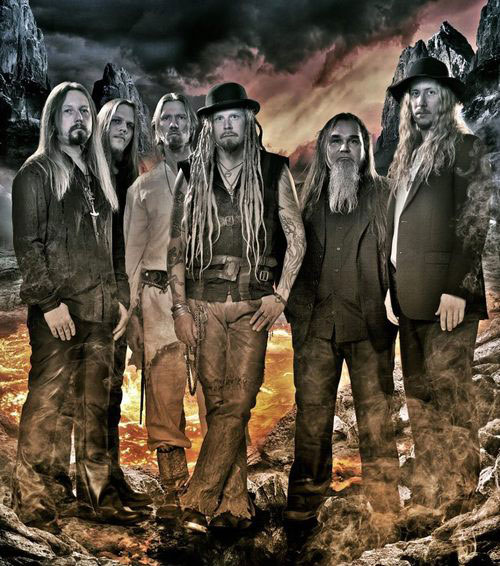 I talk with accordionist Juho Kauppinen.
I talk with accordionist Juho Kauppinen.
How are you doing these days?
„We are doing very well. Thank you for asking! We have just finished everything concerning our newest album "Manala", which is going to be released in August. A short while ago we toured in Argentina, Chile, Brazil and Uruguay. The tour was amazing and it was a great pleasure for all of us to see again the fans that we first played to in 2010. Now we're recharging our batteries for summer festivals and our next North American and European tours that will take place next fall. We are going to add a lot of new songs from the album "Manala" to our setlist.“
How do you spending your weekends in the summertime, beside all live duties?
„I don't think our hobbies are extremely different from those of any other people. For example Jonne is so busy he mainly wants to spend all his free time with his family. My hobbies are very simple and ordinary: reading and cycling. In Finland people actually also enjoy doing nothing in their free time.“
Please report about the line-up change, regarding new recruited fiddler Tuomas!
„I think this time we really needed this change. It was clearly a change for the better. Tuomas has showed his abilities as a violinist more than well. He has also brought something unique to our live shows by his extraordinary costume and performance. Now there is even a solo spot for him, in which he plays his own solo project's instrumental song that works as a really good spice in the middle of the set.“
Please describe the character of Tuomas with a few words! Does he drink very much, such as boozer Jonne?
„Tuomas seems to be a sociable and spiritual person. He gets along well with almost anybody and especially with all other members of the band. Tuomas drinks very little. He may very occasionally have a drink or two, though. Our manager David proclaims that the "folk department" (meaning the accordionist and the violinist) doesn't drink. That's true, because I quit drinking completely in 2007.“
How ran the works for the new album under the aspect of the line-up change?
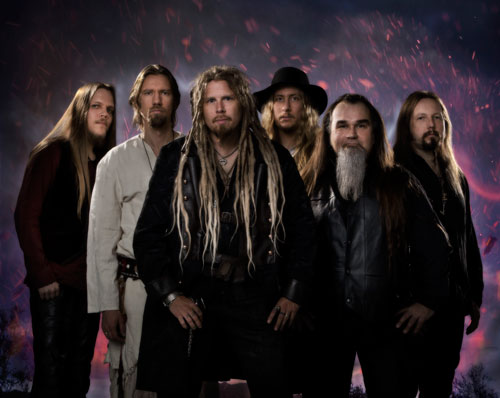 „The recording process was a little laborious, but well worth the effort. One element making it more time-consuming was the fact that the songs, except for one song, were sung in both Finnish and English. "Manala" was the third album with us for the producer Aksu Hanttu, who again proved his skills as an incredibly hard-working wizard. He didn't allow anybody to play anything mediocre. Everything needed to be splendid and that's precisely what the result is like. None of the colossal number of hours we spent on recording was in vain. The approach in general was a little different and well-thought-out. For instance, all of the main traditional instruments such as the violin, the accordion, the flutes and the recorders were recorded in turns, in such a way that the producer had set up the recording equipment for all of these instruments at once. This enabled us to come up with various ideas and immediately test whether they work or not.“
„The recording process was a little laborious, but well worth the effort. One element making it more time-consuming was the fact that the songs, except for one song, were sung in both Finnish and English. "Manala" was the third album with us for the producer Aksu Hanttu, who again proved his skills as an incredibly hard-working wizard. He didn't allow anybody to play anything mediocre. Everything needed to be splendid and that's precisely what the result is like. None of the colossal number of hours we spent on recording was in vain. The approach in general was a little different and well-thought-out. For instance, all of the main traditional instruments such as the violin, the accordion, the flutes and the recorders were recorded in turns, in such a way that the producer had set up the recording equipment for all of these instruments at once. This enabled us to come up with various ideas and immediately test whether they work or not.“
„Manala“, the realm of the dead - the underworld in Finnish mythology out of the famous Kalevala epos, is the main topic on your new release.
Please describe the background topic a bit!
„In the Finnish mythology, the dead wander in the Underworld as shadow-like ghosts. No matter whether you are good or evil, your destiny will be the same. This is the main distinction between Christianity's hell and heaven and Manala, the Underworld. At times living people went to the Underworld to fetch information or spells. The journey to the Underworld took weeks and weeks of travel through wilderness and eventually you needed to cross the river of Tuoni with the aid of a ferryman. Shamans were able to travel to the Underworld by falling into trance and by fooling the guards. Väinämöinen, one of the most central characters in the Kalevala, makes an unsuccessful trip to the Underworld, eventually managing to get back to the land of the living by turning into a snake. The Underworld was located underground or underwater or on an island and according to certain beliefs it was dark, bleak and gloomy. The Underworld was thought to be in the North. Judging from burial methods, the souls in the Underworld are believed to have continued their lives much in the same way as when still alive. Some jewelry, weapons and clothes among other things have been left on the graves of the Underworld. In some traditions the dead were asleep or led a quiet life in the Underworld. Those who were evil or immoral had worse circumstances than the others, for example a stony bed. There are some narratives about a vicious place such as an intestine of the pike. Those who ended up there could not be called back even by a shaman. The dead did not end up in the Underworld directly, but needed to travel there. Their souls may have stayed at their relatives' for some time, but at some point they had to go - no later than when the relatives chased away the creature who had turned from a dear relative into a frightening ghost. It was counted in the advantage of the living that the dead went to the Underworld, as they were away and didn't haunt, but could be reached if help was needed. There was invaluable knowledge in the Underworld, apparently thanks to the seers and relatives ended up in the Underworld. Even a living person could get a glimpse of this information by "visiting the Underworld". One way to get to the Underworld was to fall in trance. If a seer wanted to get to the Underworld, he had to undergo many challenges. For example, they needed to lie to the maid of the Underworld that they were dead, or manage to swim across a dangerous river. You also needed to get away from the Underworld if you wanted to get back to the land of the living.“
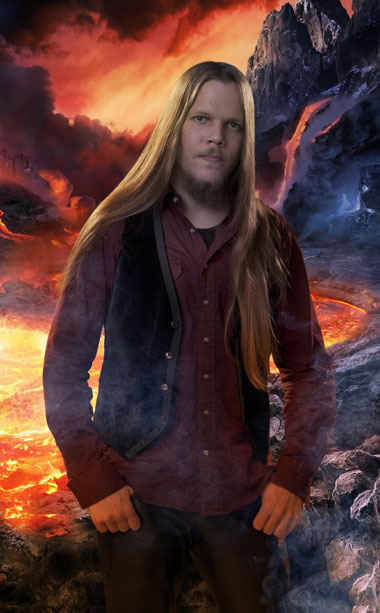 Which differences to the previous album „Ukon Wacka“ are waiting now for the Korpiklaani listeners?
Which differences to the previous album „Ukon Wacka“ are waiting now for the Korpiklaani listeners?
„The first remarkable difference is that the album is actually a double-CD, consisting of a Finnish and an English album. The second remarkable difference to previous albums is that the album has greater variety of songs. I have often said this when describing our newest album, but this time the record really oozes folk and Metal, each of which being very prominent. There is greater contrast between songs, ranging from an atmospheric acoustic song "Synkkä" (Dark Side) to pure Thrash Metal "Petoeläimen Kuola" (The Predator's Saliva). "Manala": no matter what we do at this point, be it typical of Korpiklaani or not, it will eventually sound like Korpiklaani and a listener will almost immediately recognize the band. The first three songs of the album are rather simple and infectious, each of which are obviously meant to be sung along. The third song "Rauta" (The Steel) was chosen as a video song. The fourth song is an exceptional one for Korpiklaani, having an even oriental vibe to it. "Petoeläimen Kuola" (The Predator's Saliva) is pure Thrash metal, undoubtedly one of the heaviest Korpiklaani songs ever, having our American friends Joey and Pat as guest musicians in the English version. The Thrash Metal hell is followed by an atmospheric campfire-like song "Synkkä" (Dark Side), in which a variety of sounds and ideas are used. "Ievan Polkka" (Ieva's Polka) is a cover song from 1930's. "Husky Sledge" is Tuomas's composition, being entirely instrumental. "Uni" (Dream) is a high-tempo piece, followed by "Metsälle" (Off To The Hunt), which was released as a single as early as last year. The last song of the album is "Sumussa Hämärän Aamun" (In The Mist Of A Dark Morning) which represents the darkest and gloomiest side of Korpiklaani. Because it is a little difficult to describe music in greater detail, I could probably shed some light on the lyrical side of the album by the following description of the songs:
1. "Kunnia" / Honor:
The song "Honor" suggests you should never commit suicide, because the future generations do not want to pray for the ancestors who have. It is essential to honor the people among your ancestors whose life, character and deeds deserve to be honored and whose effect you want to feel in your own life. Those who commit suicide arrive in the Underworld after their death like the others, but they will barely be honored by their future generations.
2. "Tuonelan Tuvilla" / At The Huts Of The Underworld:
In the mythological beginning, Väinämöinen and Joukahainen end up against each other and Väinämöinen outsings Joukahainen, literally in such a way that Joukahainen sinks in the swamp. Angry about this, Joukahainen chooses to shoot Väinämöinen with an arrow. He works a bow and arrows. Joukahainen's mother tries to forbid him, but regardless of his mother's advice he shoots Väinämöinen off the back of his blue moose into the primeval sea.
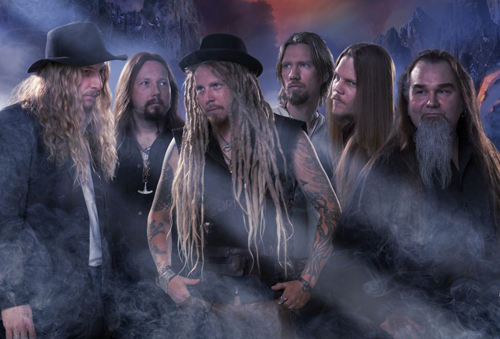 3. "Rauta" / The Steel:
3. "Rauta" / The Steel:
Iron (which is the Steel in the song title, meaning sword) is born in the busts of nymphs, out of which it flows into the swamp. A blacksmith Ilmarinen picks a white, red and black iron-piece from the ground, taking them to his forge. Ilmarinen tells iron to promise never to turn against humans nor shed innocent blood. (Eventually, after hardening iron in lye, iron goes mad and from then on has struck humans and shed innocent blood.)
4. "Ruumiinmultaa" / Soil Of The Corpse:
Soil Of The Corpse was a folk belief related to the pursuit of financial success, known in the area of Lapland. The one who desired to get rich made a deal with the devil, secretly collecting soil in the graveyard and offering it to other people, having had it mixed in their spirits and coffee. Soil Of The Corpse was only allowed to be given to those who were not enemies of the ones giving the soil of the corpse. A person who drank the soil of the corpse either died or lost his sanity permanently or temporarily. In contrast, the one giving the soil of the corpse gained financial wealth, as long as he was able to stick to the contract made with the devil, giving the soil to new victims on regular intervals for a few months. If the terms were not met, the devil killed the giver of the soil or made him insane. They say the belief lives on in certain regions of Lapland.
5. "Petoeläimen Kuola" / The Predator's Saliva:
The song deals with the birth of beer. Osmotar, the father of beer prepares the first ever beer out of barley grown by Pellonpekko. He rubs his hands, which results in the birth of animals that fetch the seasonings for the beer from the forest. However, the beer does not ferment. Osmotar finds the means and tells to get the predator's saliva. That's what happened and the beer began to ferment.
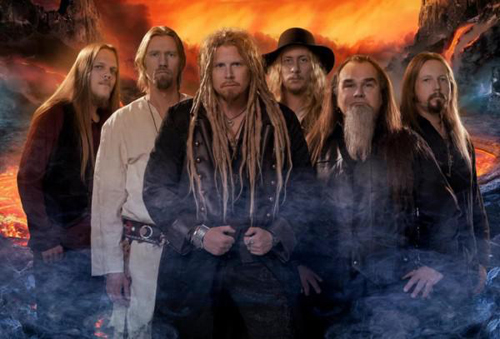 6. "Synkkä" / Dark Side:
6. "Synkkä" / Dark Side:
Joukahainen is one of the creators and brothers. Ilmarinen is the god of the sky and the air, whereas Väinämöinen's divinity is strongly connected with water. Joukahainen, the youngest brother, is the god of Earth, appearing as a dark god and gloomy god with counterforce in forests, swamps, stony grounds. The balance of the Earth is maintained by the dualistic relationship between Joukahainen and Väinämöinen. The songs is about how Joukahainen appears in nature. In addition it deals with awe among people.
8. "Husky Sledge":
This song was originally sung by a Koryak shaman in the Kamtchatka peninsula. Here it is recomposed for violin and ankle bells in the style of Rounakari's Shamanviolin project.
10. "Uni / Dream":
In folklore, dream is seen as a creature who comes to make a human fall asleep. The strong connection between death and dream has been believed to have come from the Underworld, the land of the dead. Dream binds and weaves up the eyelids, shoots with a drowsy arrow and in many other ways gets you off to sleep. When asleep, a human falls onto the level of the Underworld, in which the dream brings the Invisible world as a dream into the dreamer's mind.
11. "Metsälle" / Off To The Hunt:
Louhi, the queen of Pohjola in the Finnish mythology, has told Lemminkäinen to go in pursuit of Hiisi's moose. While in pursuit, he breaks / loses his skis and poles, begging for Ukko the thundergod to make him new skis, by which he could catch the moose up and complete his task. Lemminkäinen skis and chases after the moose in the land of Tapiola.
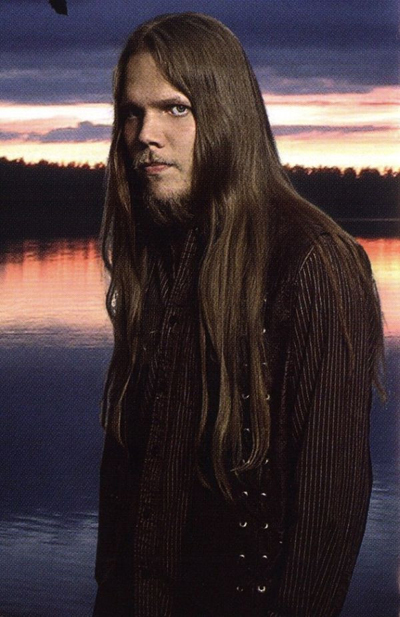 12. "Sumussa Hämärän Aamun" / In The Mist Of A Dark Morning:
12. "Sumussa Hämärän Aamun" / In The Mist Of A Dark Morning:
Ututyttö or Terhenneiti is the sprite of fog and mist. In misty weather a lot of ghosts have been told to have been seen. Some of them are restless souls, who have been left to wander in this world, but some of them are visions from the land of the dead, the Underworld. Fog and mist make the borders of the two worlds more and more indefineable, to such a degree that we can see the land of the dead with its ancestors in the world of the afterlife. Due to this, Ututyttö is also called the Bringer of Death.“
With which expectation(s) had begun the writing of the songs for the new Korpiklaani release?
„The main composer Jonne has barely any pressure when he composes new material. Songwriting comes easy to him and he wants to keep it that way. It is like therapy for him and without a doubt one of the most enjoyable things in his life. He hears the music in his head in even in most inopportune circumstances like when lying down to rest, but because the melodies can't be left unwritten he goes down to his study and begins working with the song. In this way, rather easily and without further ado, Korpiklaani songs are born and in such a pace that a new album needs to be released almost every year.“
How long did last the whole songwriting for „Manala“?
„It's always a little difficult to estimate the time spent on songwriting, because a lot of the songwriting process may even be partially unfinished when entering the studio. In addition, none of us has ever really counted the time it takes to write a Korpiklaani album. The actual idea of a song may not take long to mature, but the entire process of it ending up on an album is a little more laborious.“
And who have been the main songwriters for „Manala“?
„Jonne wrote the clear majority of the songs, but "Sumussa Hämärän Aamun" (In The Mist Of A Dark Morning) and partly "Uni" (Dream) were written by Jarkko, whereas the fully instrumental song "Husky Sledge" is Tuomas's composition.“
The lyrical content of „Manala“ deals mainly with the adventures of an shamanic hero. What’s your personal view about the ,shamanic spirit‘ of the new album? Is there one at all? The music seems better to be for celebrating, drinking beer and be happy…
„Yes, the shamanistic spirit is definitely there and it can be heard in many songs, especially in the instrumental one "Husky Sledge".“
© Markus Eck, 28.07.2012
[ to overview ]
Multiple five-star rated PR Agency that works professionally and reliably with numerous partners in the worldwide music media.
Many years of extensive and in-depth experience in various musical fields form the basis for an individual and efficient service at Metal Message ᴳᴸᴼᴮᴬᴸ.
Main field of activity besides communication for global Public Relations are integrated Promotion Campaigns in print, online and broadcast, as well as marketing, artist management, consulting and mentoring.
Just like an exquisite manufactory - where passion meets profession!
Merch
•
Releases
•
Concerts
•
Cover Art Mediation
•
Media Area
•
Global Fame
•
Iron Talks • Podcast
ATMósferas Magazine
Bleeding4Metal
Crossfire Metal
Darkzen Dragon
Epic Metal Blog
Filthy Dogs Of Metal
Frenzy Fire
Hanf- und Wander-Metaller
Highwire Daze Online
Legacy
MetalUnderground AT
Metal Addicts
Metal Gods TV
Metal Opera
Metal Pedia
Metal Temple
Metal Titans
Pete's Rock News And Views
Powermetal DE
Stormbringer
The Cosmick View
The Murder Inn
Time For Metal
Via Nocturna
World Of Metal
X-Reviews
Zephyr's Odem
1921 Baliheadbanger
Demontre Radio
Das Metalmagazin hart&direkt
Hijos De La Luna
La Caverna De Hierro
Loud And Proud
Metal Only
Metal Tavern Radio
PowerPlant Radio NL
Radio Diabolus
PODCASTS
LABELS
Disclaimer
Impressum
Datenschutzerklärung
•
FAQ
•
Design & Programming
Help Metal Message ᴳᴸᴼᴮᴬᴸ • 𝐸𝓈𝓉. 2001 with your donation via 𝗣𝗮𝘆𝗣𝗮𝗹 to give its artist clients worldwide the most dedicated & professional support!
© Metal Message ᴳᴸᴼᴮᴬᴸ • 2001-2024 • All rights reserved
Unauthorized use and/or duplication of this material without express and written permission from this site’s author and/or owner is strictly prohibited.
Excerpts and links may be used, provided that full and clear credit is given to Metal Message ᴳᴸᴼᴮᴬᴸ with appropriate and specific direction to the original content.















